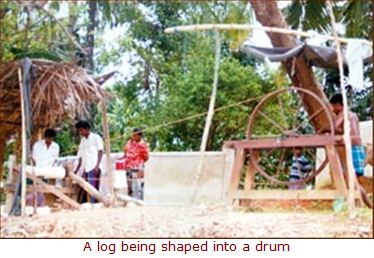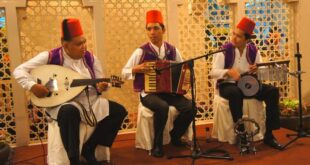Perpetuating an old craft
by ASIFF HUSSEIN
Drums never fail to liven up things. Be it the rhythmic beats of the wandering minstrel or the loud bangs of the school hevisi band, the drum speaks the language of life.
 The art of drum-making however survives in only a few localities today, the most prominent among them being Kuragala, a Rodi hamlet situated in the Udunuwara Division of Kandy District where the manufacture of drums has been practised for generations. Kuragala is a veritable hub of drums.
The art of drum-making however survives in only a few localities today, the most prominent among them being Kuragala, a Rodi hamlet situated in the Udunuwara Division of Kandy District where the manufacture of drums has been practised for generations. Kuragala is a veritable hub of drums.
The village comprises about 60 households of which about 25 are directly involved in making drums while the rest are content with providing the necessary wage labour as they do not have the capital to embark on the venture themselves. All indications however, are that the industry here is a thriving one though there remains some problems to be addressed such as the entry of middlemen into the scene and the lack of marketing facilities.
Great variety
Kuragala manufactures a great variety of drums, comprising about 26 types in all, according to a well-experienced drum-maker, Premaratna, who along with his wife Chandravati and other relatives runs a thriving family business. Premaratna explained that he usually works according to orders and could execute an order within a matter of three days. He said that they manufactured as many as 20-25 pieces a month.
Among the kinds of drums he manufactures are the raban (a large one-sided drum played with the hand), magul bera or geta bera (the two-sided, barrel-shaped upcountry drum), the yak bera, dik bera or devol bera (the cylindrical low-country drum), davula (Sabaragamuva drum), temmetta (a twin drum with faces turned upwards) and the dakki and udakki (lacquered hour glass-like drums). The other types of drums he manufactures are the dolki, dolek and little children’s drums.
Premaratna however claims that drum-making today is not as profitable as it used to be due to the difficulty in obtaining tree trunks for making drums. The kos or jak tree which goes into the making of the better drums such as the magul bera is not only expensive, but also takes time to procure as it requires a permit which is a long drawn out process. The time factor, he pointed out, was critical and tended to stifle the industry.
Another type of wood he commonly employs is the pol or coconut tree obtained from mills in the Kurunegala area. A small tree could yield about 10-12 pieces while a large tree could produce as much as 20-25 pieces, he explained. The other kinds of trees he uses are gini sapu for the dakki and udakki and albisiya for little children’s drums. The raban, he observed, was now becoming increasingly difficult to manufacture due to the scarcity of large trees. This however does not appear to pose any real problem as it is the magul bera which has the greatest demand.
 Kandyan beat
Kandyan beat
As for the animal hides which are ultimately responsible for giving the drums their characteristic sound, these comprise either cow or goat hide, depending on the variety of drum. For instance, in the case of the magul bere the left side has invariably to be of cow hide while the right side has to be of goat hide.
The cow hide gives the left side of the drum its characteristic dull sound while the goat hide imparts to the right side the sharp sounds so vital for the variety of the Kandyan beat. Although monkey skin was formerly used instead of goat’s hide, this is no longer the case, he observed. Children’s drums, he said, are usually made with goat hide. Premaratna procures cow hide from butcher shops in Gampola and goat hide from some suppliers who worked for Kadar Saibo, an old company in Kandy dealing with animal hide
 Asiff Hussein – Asiff Hussein Web Site
Asiff Hussein – Asiff Hussein Web Site




